Understanding and Leading Change: A Report on Tesco's Strategies
VerifiedAdded on 2020/10/22
|21
|5953
|330
Report
AI Summary
This report provides a comprehensive analysis of Tesco's approach to understanding and leading organizational change. It begins with an introduction highlighting the importance of adapting to changes in the global market, using Tesco as a case study. The report then delves into the impact of change on Tesco's strategies and operations, comparing them to Sainsbury's and examining the influence of technological and social changes. It identifies drivers of change, including technological advancements and customer demands. The report explores how external and internal factors affect leadership, individual behavior, and team dynamics, utilizing PESTLE and SWOT analyses to assess the business environment. It also examines leadership approaches for successful change implementation, and ways to mitigate the negative impact of change. Finally, the report concludes by summarizing the key findings and implications for Tesco's future strategies.
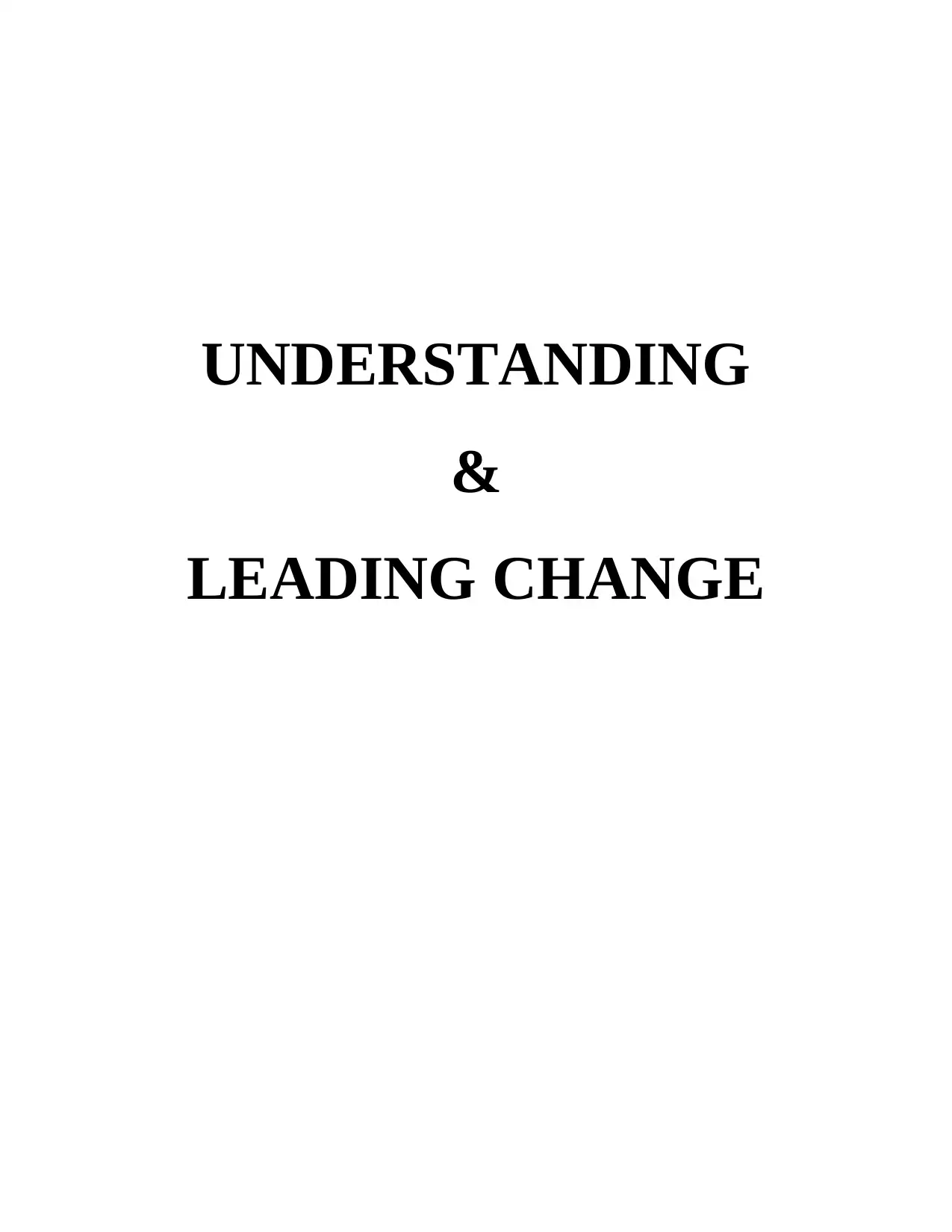
UNDERSTANDING
&
LEADING CHANGE
&
LEADING CHANGE
Paraphrase This Document
Need a fresh take? Get an instant paraphrase of this document with our AI Paraphraser
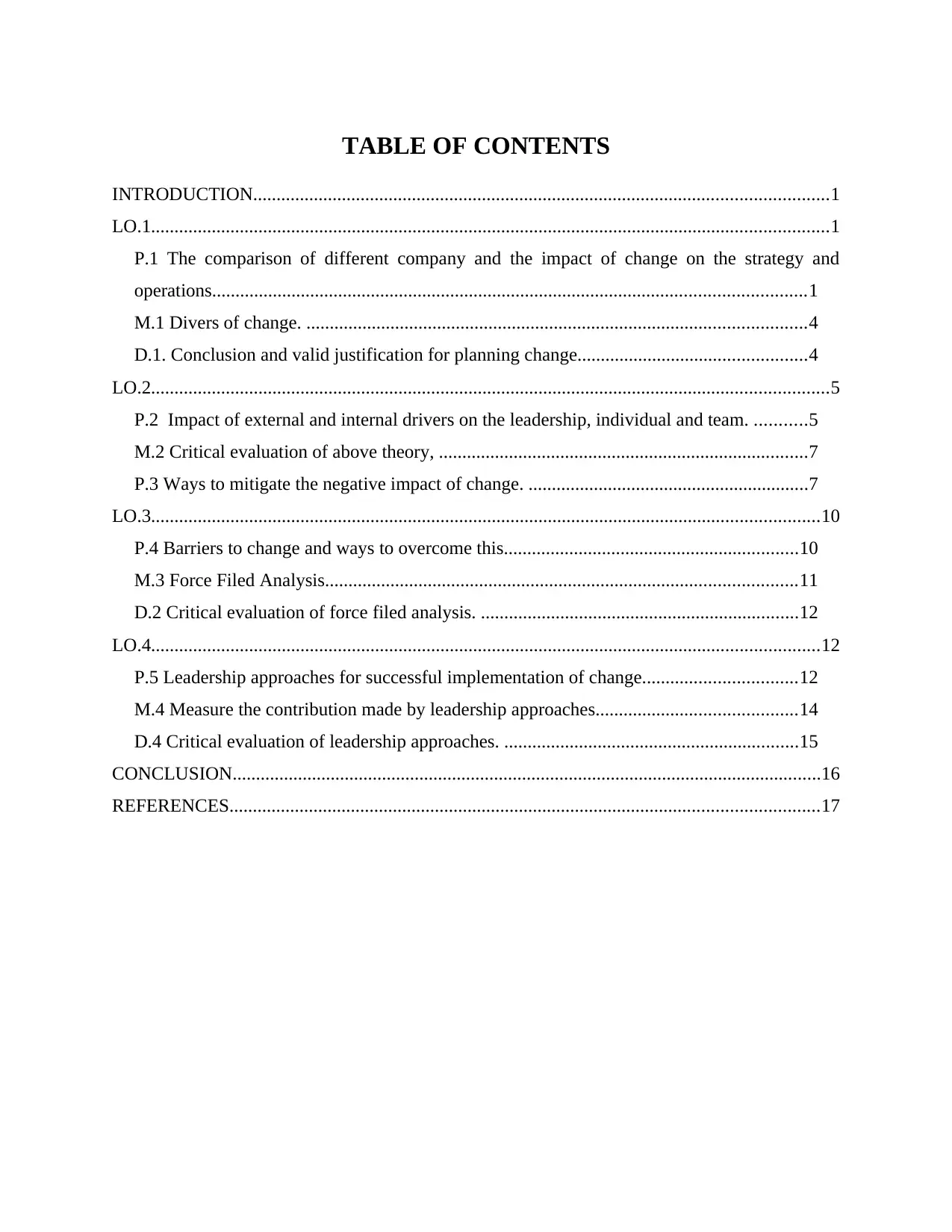
TABLE OF CONTENTS
INTRODUCTION...........................................................................................................................1
LO.1.................................................................................................................................................1
P.1 The comparison of different company and the impact of change on the strategy and
operations...............................................................................................................................1
M.1 Divers of change. ...........................................................................................................4
D.1. Conclusion and valid justification for planning change.................................................4
LO.2.................................................................................................................................................5
P.2 Impact of external and internal drivers on the leadership, individual and team. ...........5
M.2 Critical evaluation of above theory, ...............................................................................7
P.3 Ways to mitigate the negative impact of change. ............................................................7
LO.3...............................................................................................................................................10
P.4 Barriers to change and ways to overcome this...............................................................10
M.3 Force Filed Analysis.....................................................................................................11
D.2 Critical evaluation of force filed analysis. ....................................................................12
LO.4...............................................................................................................................................12
P.5 Leadership approaches for successful implementation of change.................................12
M.4 Measure the contribution made by leadership approaches...........................................14
D.4 Critical evaluation of leadership approaches. ...............................................................15
CONCLUSION..............................................................................................................................16
REFERENCES..............................................................................................................................17
INTRODUCTION...........................................................................................................................1
LO.1.................................................................................................................................................1
P.1 The comparison of different company and the impact of change on the strategy and
operations...............................................................................................................................1
M.1 Divers of change. ...........................................................................................................4
D.1. Conclusion and valid justification for planning change.................................................4
LO.2.................................................................................................................................................5
P.2 Impact of external and internal drivers on the leadership, individual and team. ...........5
M.2 Critical evaluation of above theory, ...............................................................................7
P.3 Ways to mitigate the negative impact of change. ............................................................7
LO.3...............................................................................................................................................10
P.4 Barriers to change and ways to overcome this...............................................................10
M.3 Force Filed Analysis.....................................................................................................11
D.2 Critical evaluation of force filed analysis. ....................................................................12
LO.4...............................................................................................................................................12
P.5 Leadership approaches for successful implementation of change.................................12
M.4 Measure the contribution made by leadership approaches...........................................14
D.4 Critical evaluation of leadership approaches. ...............................................................15
CONCLUSION..............................................................................................................................16
REFERENCES..............................................................................................................................17
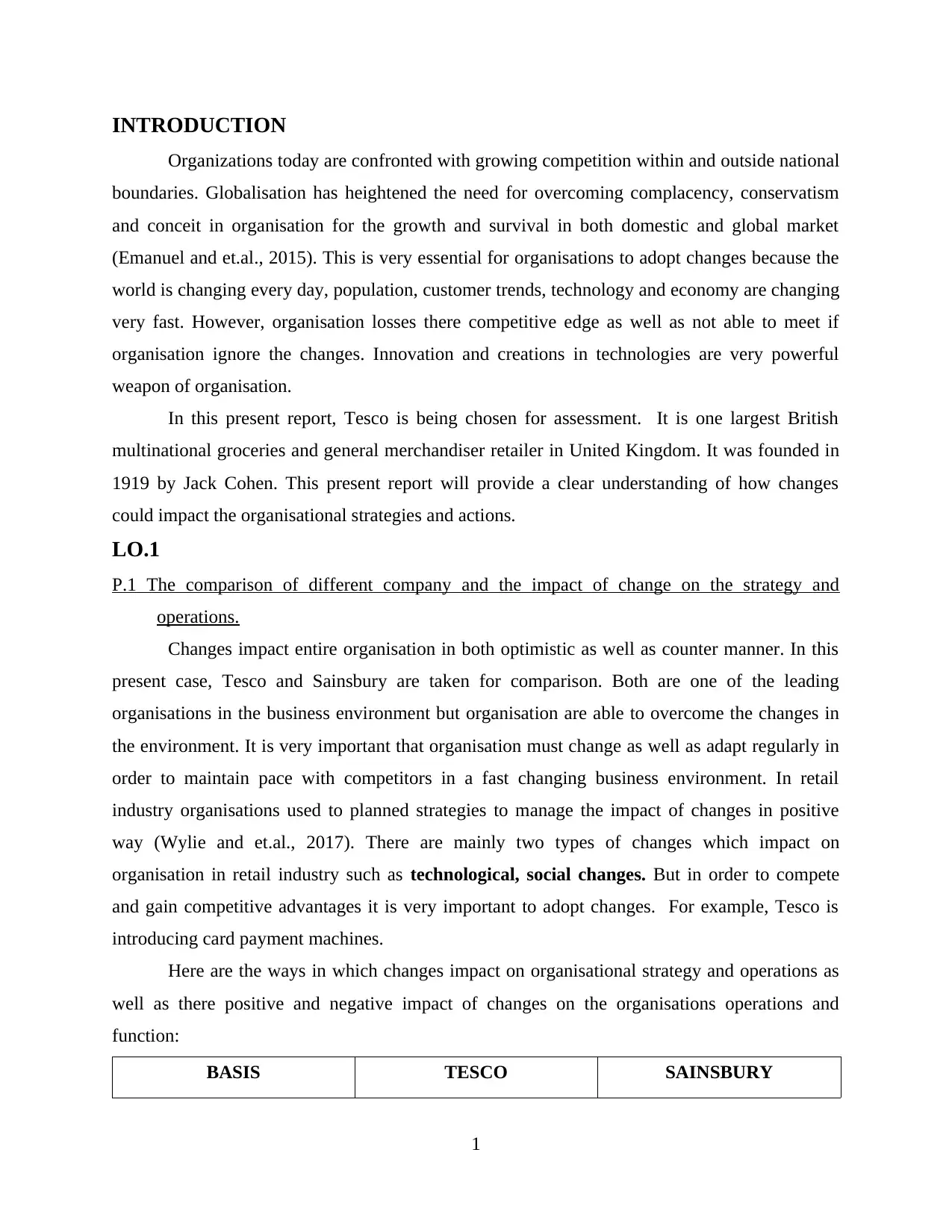
INTRODUCTION
Organizations today are confronted with growing competition within and outside national
boundaries. Globalisation has heightened the need for overcoming complacency, conservatism
and conceit in organisation for the growth and survival in both domestic and global market
(Emanuel and et.al., 2015). This is very essential for organisations to adopt changes because the
world is changing every day, population, customer trends, technology and economy are changing
very fast. However, organisation losses there competitive edge as well as not able to meet if
organisation ignore the changes. Innovation and creations in technologies are very powerful
weapon of organisation.
In this present report, Tesco is being chosen for assessment. It is one largest British
multinational groceries and general merchandiser retailer in United Kingdom. It was founded in
1919 by Jack Cohen. This present report will provide a clear understanding of how changes
could impact the organisational strategies and actions.
LO.1
P.1 The comparison of different company and the impact of change on the strategy and
operations.
Changes impact entire organisation in both optimistic as well as counter manner. In this
present case, Tesco and Sainsbury are taken for comparison. Both are one of the leading
organisations in the business environment but organisation are able to overcome the changes in
the environment. It is very important that organisation must change as well as adapt regularly in
order to maintain pace with competitors in a fast changing business environment. In retail
industry organisations used to planned strategies to manage the impact of changes in positive
way (Wylie and et.al., 2017). There are mainly two types of changes which impact on
organisation in retail industry such as technological, social changes. But in order to compete
and gain competitive advantages it is very important to adopt changes. For example, Tesco is
introducing card payment machines.
Here are the ways in which changes impact on organisational strategy and operations as
well as there positive and negative impact of changes on the organisations operations and
function:
BASIS TESCO SAINSBURY
1
Organizations today are confronted with growing competition within and outside national
boundaries. Globalisation has heightened the need for overcoming complacency, conservatism
and conceit in organisation for the growth and survival in both domestic and global market
(Emanuel and et.al., 2015). This is very essential for organisations to adopt changes because the
world is changing every day, population, customer trends, technology and economy are changing
very fast. However, organisation losses there competitive edge as well as not able to meet if
organisation ignore the changes. Innovation and creations in technologies are very powerful
weapon of organisation.
In this present report, Tesco is being chosen for assessment. It is one largest British
multinational groceries and general merchandiser retailer in United Kingdom. It was founded in
1919 by Jack Cohen. This present report will provide a clear understanding of how changes
could impact the organisational strategies and actions.
LO.1
P.1 The comparison of different company and the impact of change on the strategy and
operations.
Changes impact entire organisation in both optimistic as well as counter manner. In this
present case, Tesco and Sainsbury are taken for comparison. Both are one of the leading
organisations in the business environment but organisation are able to overcome the changes in
the environment. It is very important that organisation must change as well as adapt regularly in
order to maintain pace with competitors in a fast changing business environment. In retail
industry organisations used to planned strategies to manage the impact of changes in positive
way (Wylie and et.al., 2017). There are mainly two types of changes which impact on
organisation in retail industry such as technological, social changes. But in order to compete
and gain competitive advantages it is very important to adopt changes. For example, Tesco is
introducing card payment machines.
Here are the ways in which changes impact on organisational strategy and operations as
well as there positive and negative impact of changes on the organisations operations and
function:
BASIS TESCO SAINSBURY
1
⊘ This is a preview!⊘
Do you want full access?
Subscribe today to unlock all pages.

Trusted by 1+ million students worldwide
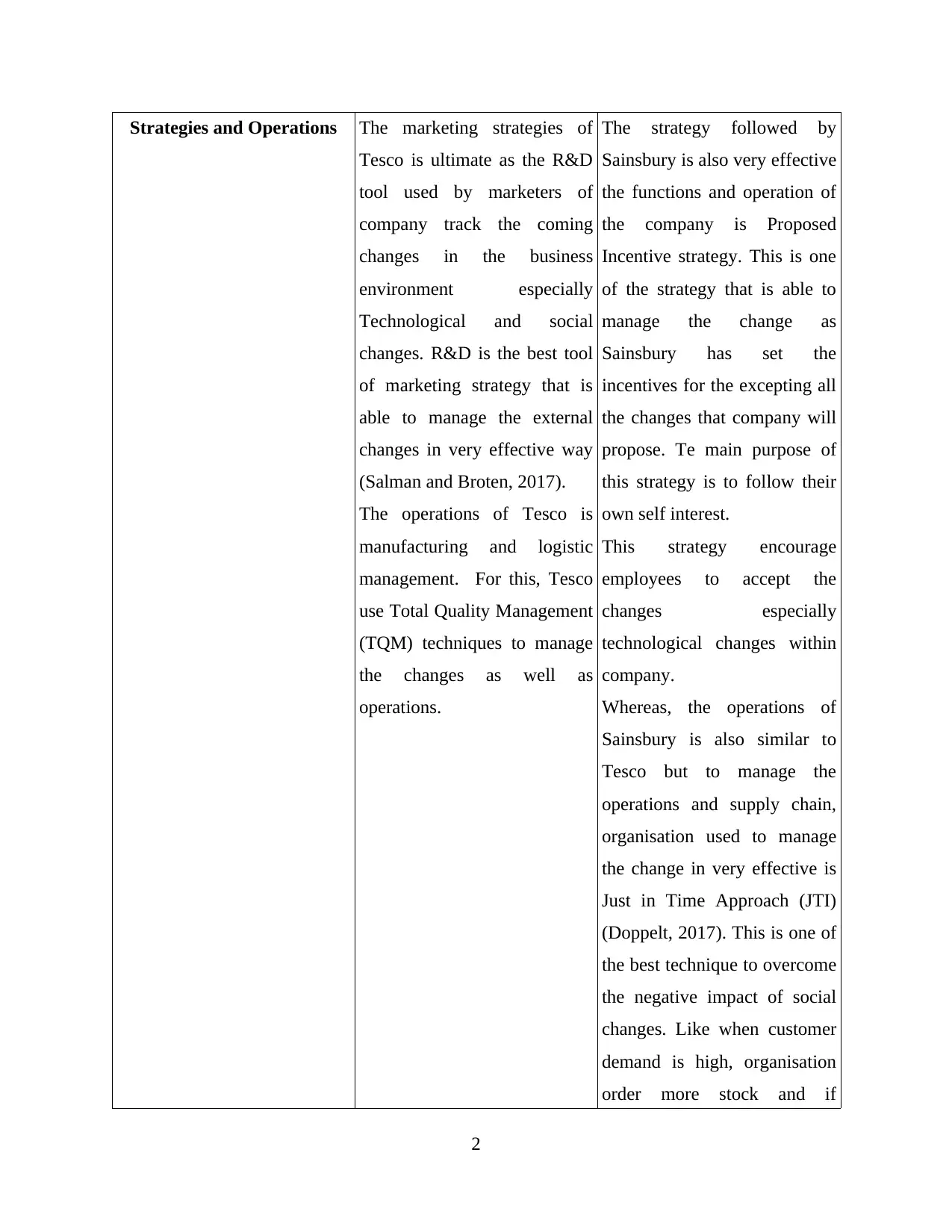
Strategies and Operations The marketing strategies of
Tesco is ultimate as the R&D
tool used by marketers of
company track the coming
changes in the business
environment especially
Technological and social
changes. R&D is the best tool
of marketing strategy that is
able to manage the external
changes in very effective way
(Salman and Broten, 2017).
The operations of Tesco is
manufacturing and logistic
management. For this, Tesco
use Total Quality Management
(TQM) techniques to manage
the changes as well as
operations.
The strategy followed by
Sainsbury is also very effective
the functions and operation of
the company is Proposed
Incentive strategy. This is one
of the strategy that is able to
manage the change as
Sainsbury has set the
incentives for the excepting all
the changes that company will
propose. Te main purpose of
this strategy is to follow their
own self interest.
This strategy encourage
employees to accept the
changes especially
technological changes within
company.
Whereas, the operations of
Sainsbury is also similar to
Tesco but to manage the
operations and supply chain,
organisation used to manage
the change in very effective is
Just in Time Approach (JTI)
(Doppelt, 2017). This is one of
the best technique to overcome
the negative impact of social
changes. Like when customer
demand is high, organisation
order more stock and if
2
Tesco is ultimate as the R&D
tool used by marketers of
company track the coming
changes in the business
environment especially
Technological and social
changes. R&D is the best tool
of marketing strategy that is
able to manage the external
changes in very effective way
(Salman and Broten, 2017).
The operations of Tesco is
manufacturing and logistic
management. For this, Tesco
use Total Quality Management
(TQM) techniques to manage
the changes as well as
operations.
The strategy followed by
Sainsbury is also very effective
the functions and operation of
the company is Proposed
Incentive strategy. This is one
of the strategy that is able to
manage the change as
Sainsbury has set the
incentives for the excepting all
the changes that company will
propose. Te main purpose of
this strategy is to follow their
own self interest.
This strategy encourage
employees to accept the
changes especially
technological changes within
company.
Whereas, the operations of
Sainsbury is also similar to
Tesco but to manage the
operations and supply chain,
organisation used to manage
the change in very effective is
Just in Time Approach (JTI)
(Doppelt, 2017). This is one of
the best technique to overcome
the negative impact of social
changes. Like when customer
demand is high, organisation
order more stock and if
2
Paraphrase This Document
Need a fresh take? Get an instant paraphrase of this document with our AI Paraphraser
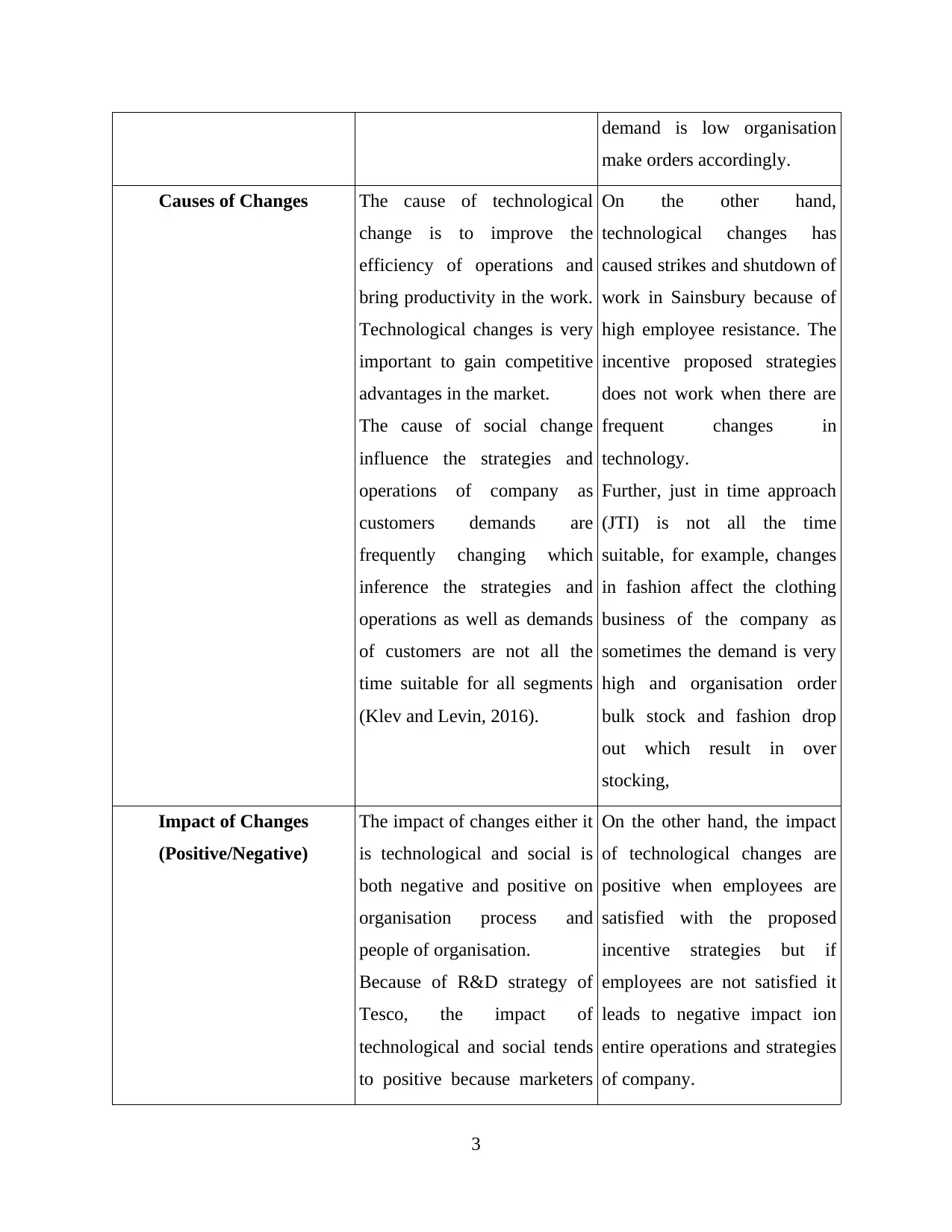
demand is low organisation
make orders accordingly.
Causes of Changes The cause of technological
change is to improve the
efficiency of operations and
bring productivity in the work.
Technological changes is very
important to gain competitive
advantages in the market.
The cause of social change
influence the strategies and
operations of company as
customers demands are
frequently changing which
inference the strategies and
operations as well as demands
of customers are not all the
time suitable for all segments
(Klev and Levin, 2016).
On the other hand,
technological changes has
caused strikes and shutdown of
work in Sainsbury because of
high employee resistance. The
incentive proposed strategies
does not work when there are
frequent changes in
technology.
Further, just in time approach
(JTI) is not all the time
suitable, for example, changes
in fashion affect the clothing
business of the company as
sometimes the demand is very
high and organisation order
bulk stock and fashion drop
out which result in over
stocking,
Impact of Changes
(Positive/Negative)
The impact of changes either it
is technological and social is
both negative and positive on
organisation process and
people of organisation.
Because of R&D strategy of
Tesco, the impact of
technological and social tends
to positive because marketers
On the other hand, the impact
of technological changes are
positive when employees are
satisfied with the proposed
incentive strategies but if
employees are not satisfied it
leads to negative impact ion
entire operations and strategies
of company.
3
make orders accordingly.
Causes of Changes The cause of technological
change is to improve the
efficiency of operations and
bring productivity in the work.
Technological changes is very
important to gain competitive
advantages in the market.
The cause of social change
influence the strategies and
operations of company as
customers demands are
frequently changing which
inference the strategies and
operations as well as demands
of customers are not all the
time suitable for all segments
(Klev and Levin, 2016).
On the other hand,
technological changes has
caused strikes and shutdown of
work in Sainsbury because of
high employee resistance. The
incentive proposed strategies
does not work when there are
frequent changes in
technology.
Further, just in time approach
(JTI) is not all the time
suitable, for example, changes
in fashion affect the clothing
business of the company as
sometimes the demand is very
high and organisation order
bulk stock and fashion drop
out which result in over
stocking,
Impact of Changes
(Positive/Negative)
The impact of changes either it
is technological and social is
both negative and positive on
organisation process and
people of organisation.
Because of R&D strategy of
Tesco, the impact of
technological and social tends
to positive because marketers
On the other hand, the impact
of technological changes are
positive when employees are
satisfied with the proposed
incentive strategies but if
employees are not satisfied it
leads to negative impact ion
entire operations and strategies
of company.
3
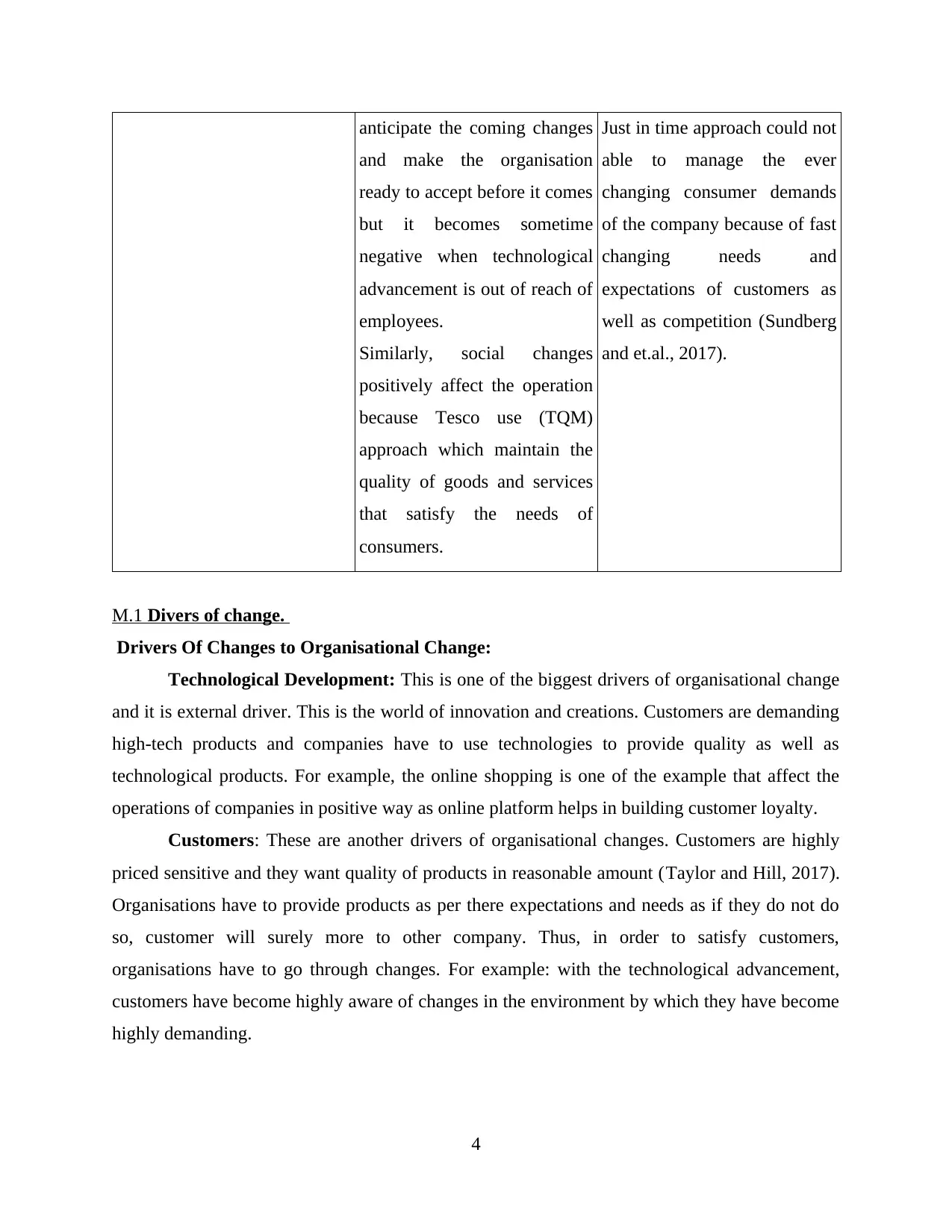
anticipate the coming changes
and make the organisation
ready to accept before it comes
but it becomes sometime
negative when technological
advancement is out of reach of
employees.
Similarly, social changes
positively affect the operation
because Tesco use (TQM)
approach which maintain the
quality of goods and services
that satisfy the needs of
consumers.
Just in time approach could not
able to manage the ever
changing consumer demands
of the company because of fast
changing needs and
expectations of customers as
well as competition (Sundberg
and et.al., 2017).
M.1 Divers of change.
Drivers Of Changes to Organisational Change:
Technological Development: This is one of the biggest drivers of organisational change
and it is external driver. This is the world of innovation and creations. Customers are demanding
high-tech products and companies have to use technologies to provide quality as well as
technological products. For example, the online shopping is one of the example that affect the
operations of companies in positive way as online platform helps in building customer loyalty.
Customers: These are another drivers of organisational changes. Customers are highly
priced sensitive and they want quality of products in reasonable amount (Taylor and Hill, 2017).
Organisations have to provide products as per there expectations and needs as if they do not do
so, customer will surely more to other company. Thus, in order to satisfy customers,
organisations have to go through changes. For example: with the technological advancement,
customers have become highly aware of changes in the environment by which they have become
highly demanding.
4
and make the organisation
ready to accept before it comes
but it becomes sometime
negative when technological
advancement is out of reach of
employees.
Similarly, social changes
positively affect the operation
because Tesco use (TQM)
approach which maintain the
quality of goods and services
that satisfy the needs of
consumers.
Just in time approach could not
able to manage the ever
changing consumer demands
of the company because of fast
changing needs and
expectations of customers as
well as competition (Sundberg
and et.al., 2017).
M.1 Divers of change.
Drivers Of Changes to Organisational Change:
Technological Development: This is one of the biggest drivers of organisational change
and it is external driver. This is the world of innovation and creations. Customers are demanding
high-tech products and companies have to use technologies to provide quality as well as
technological products. For example, the online shopping is one of the example that affect the
operations of companies in positive way as online platform helps in building customer loyalty.
Customers: These are another drivers of organisational changes. Customers are highly
priced sensitive and they want quality of products in reasonable amount (Taylor and Hill, 2017).
Organisations have to provide products as per there expectations and needs as if they do not do
so, customer will surely more to other company. Thus, in order to satisfy customers,
organisations have to go through changes. For example: with the technological advancement,
customers have become highly aware of changes in the environment by which they have become
highly demanding.
4
⊘ This is a preview!⊘
Do you want full access?
Subscribe today to unlock all pages.

Trusted by 1+ million students worldwide
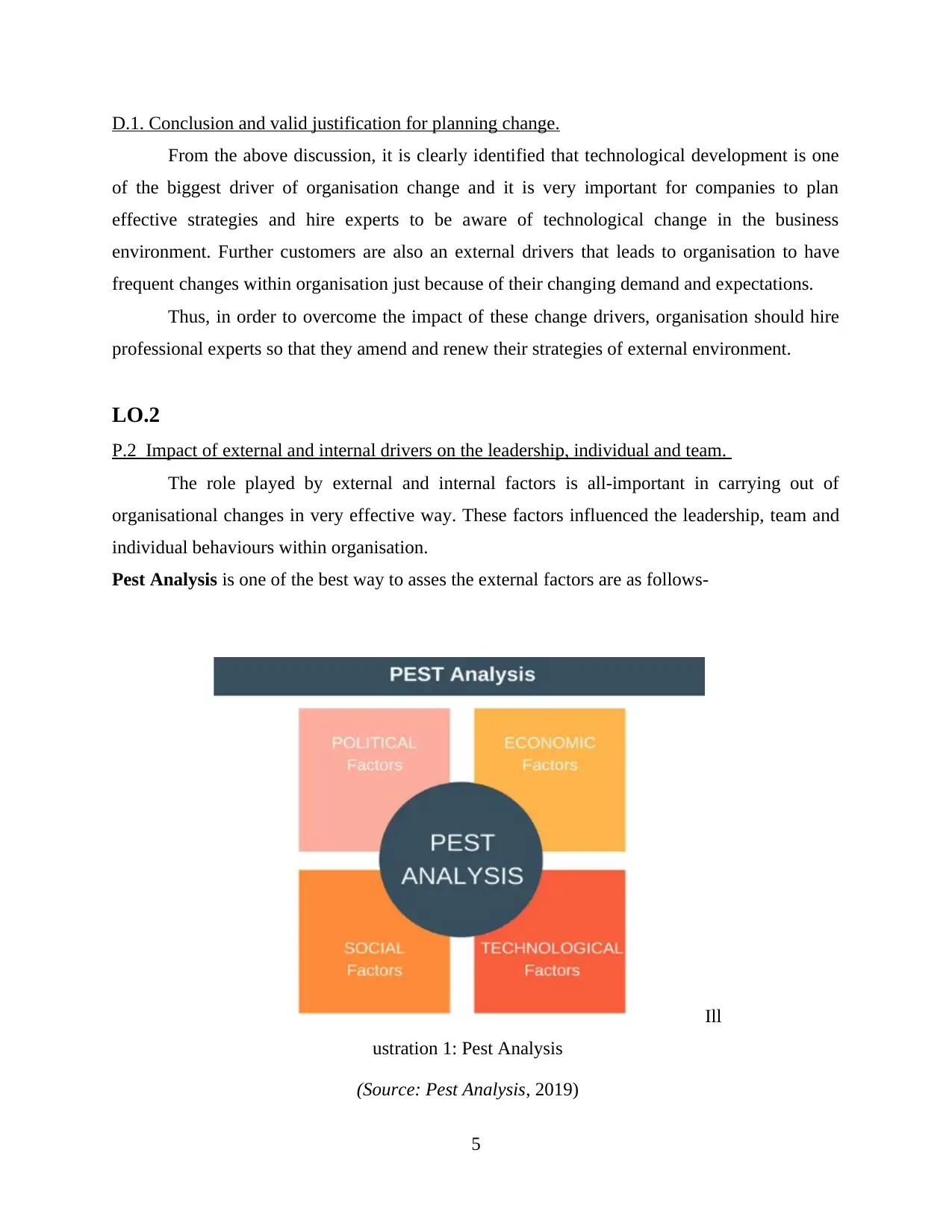
D.1. Conclusion and valid justification for planning change.
From the above discussion, it is clearly identified that technological development is one
of the biggest driver of organisation change and it is very important for companies to plan
effective strategies and hire experts to be aware of technological change in the business
environment. Further customers are also an external drivers that leads to organisation to have
frequent changes within organisation just because of their changing demand and expectations.
Thus, in order to overcome the impact of these change drivers, organisation should hire
professional experts so that they amend and renew their strategies of external environment.
LO.2
P.2 Impact of external and internal drivers on the leadership, individual and team.
The role played by external and internal factors is all-important in carrying out of
organisational changes in very effective way. These factors influenced the leadership, team and
individual behaviours within organisation.
Pest Analysis is one of the best way to asses the external factors are as follows-
5
Ill
ustration 1: Pest Analysis
(Source: Pest Analysis, 2019)
From the above discussion, it is clearly identified that technological development is one
of the biggest driver of organisation change and it is very important for companies to plan
effective strategies and hire experts to be aware of technological change in the business
environment. Further customers are also an external drivers that leads to organisation to have
frequent changes within organisation just because of their changing demand and expectations.
Thus, in order to overcome the impact of these change drivers, organisation should hire
professional experts so that they amend and renew their strategies of external environment.
LO.2
P.2 Impact of external and internal drivers on the leadership, individual and team.
The role played by external and internal factors is all-important in carrying out of
organisational changes in very effective way. These factors influenced the leadership, team and
individual behaviours within organisation.
Pest Analysis is one of the best way to asses the external factors are as follows-
5
Ill
ustration 1: Pest Analysis
(Source: Pest Analysis, 2019)
Paraphrase This Document
Need a fresh take? Get an instant paraphrase of this document with our AI Paraphraser
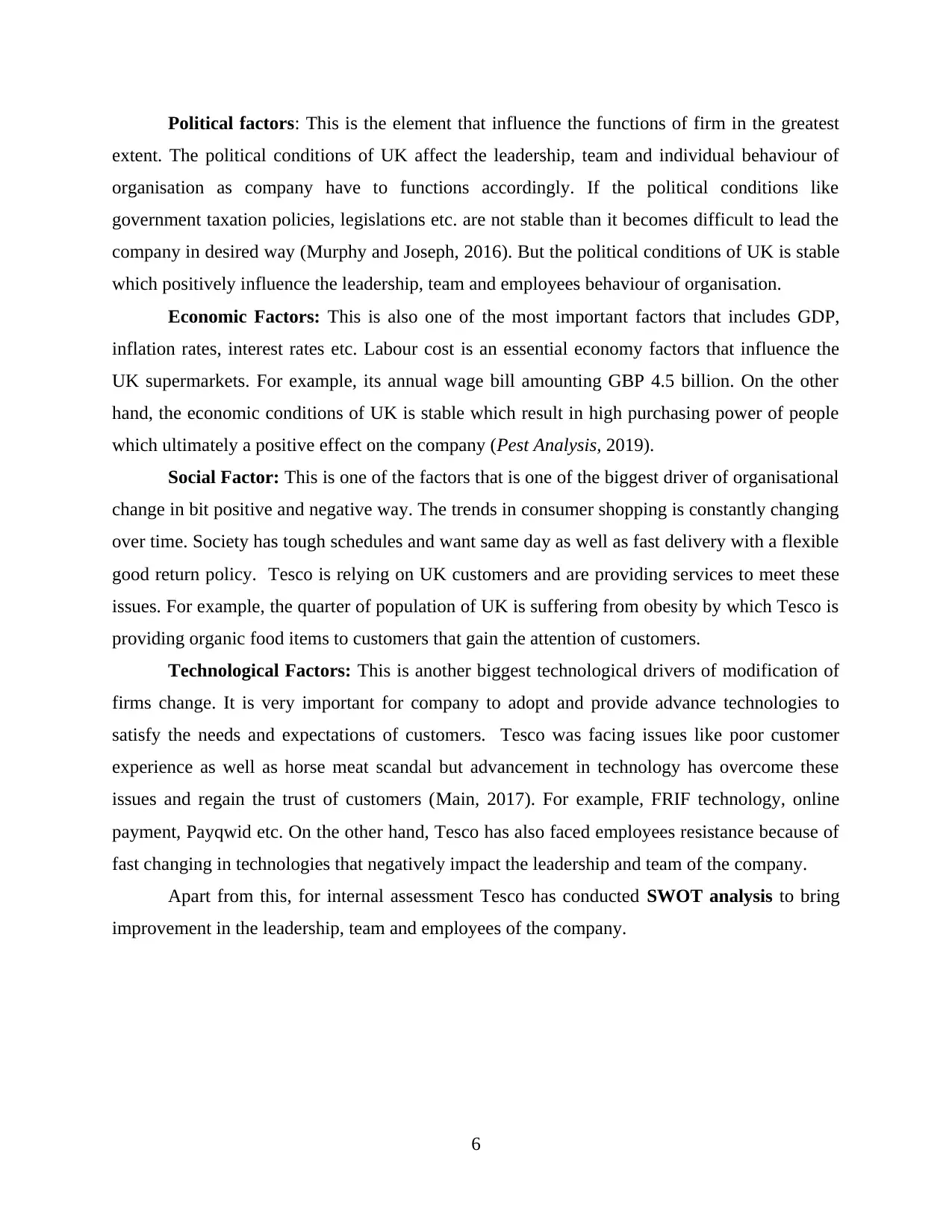
Political factors: This is the element that influence the functions of firm in the greatest
extent. The political conditions of UK affect the leadership, team and individual behaviour of
organisation as company have to functions accordingly. If the political conditions like
government taxation policies, legislations etc. are not stable than it becomes difficult to lead the
company in desired way (Murphy and Joseph, 2016). But the political conditions of UK is stable
which positively influence the leadership, team and employees behaviour of organisation.
Economic Factors: This is also one of the most important factors that includes GDP,
inflation rates, interest rates etc. Labour cost is an essential economy factors that influence the
UK supermarkets. For example, its annual wage bill amounting GBP 4.5 billion. On the other
hand, the economic conditions of UK is stable which result in high purchasing power of people
which ultimately a positive effect on the company (Pest Analysis, 2019).
Social Factor: This is one of the factors that is one of the biggest driver of organisational
change in bit positive and negative way. The trends in consumer shopping is constantly changing
over time. Society has tough schedules and want same day as well as fast delivery with a flexible
good return policy. Tesco is relying on UK customers and are providing services to meet these
issues. For example, the quarter of population of UK is suffering from obesity by which Tesco is
providing organic food items to customers that gain the attention of customers.
Technological Factors: This is another biggest technological drivers of modification of
firms change. It is very important for company to adopt and provide advance technologies to
satisfy the needs and expectations of customers. Tesco was facing issues like poor customer
experience as well as horse meat scandal but advancement in technology has overcome these
issues and regain the trust of customers (Main, 2017). For example, FRIF technology, online
payment, Payqwid etc. On the other hand, Tesco has also faced employees resistance because of
fast changing in technologies that negatively impact the leadership and team of the company.
Apart from this, for internal assessment Tesco has conducted SWOT analysis to bring
improvement in the leadership, team and employees of the company.
6
extent. The political conditions of UK affect the leadership, team and individual behaviour of
organisation as company have to functions accordingly. If the political conditions like
government taxation policies, legislations etc. are not stable than it becomes difficult to lead the
company in desired way (Murphy and Joseph, 2016). But the political conditions of UK is stable
which positively influence the leadership, team and employees behaviour of organisation.
Economic Factors: This is also one of the most important factors that includes GDP,
inflation rates, interest rates etc. Labour cost is an essential economy factors that influence the
UK supermarkets. For example, its annual wage bill amounting GBP 4.5 billion. On the other
hand, the economic conditions of UK is stable which result in high purchasing power of people
which ultimately a positive effect on the company (Pest Analysis, 2019).
Social Factor: This is one of the factors that is one of the biggest driver of organisational
change in bit positive and negative way. The trends in consumer shopping is constantly changing
over time. Society has tough schedules and want same day as well as fast delivery with a flexible
good return policy. Tesco is relying on UK customers and are providing services to meet these
issues. For example, the quarter of population of UK is suffering from obesity by which Tesco is
providing organic food items to customers that gain the attention of customers.
Technological Factors: This is another biggest technological drivers of modification of
firms change. It is very important for company to adopt and provide advance technologies to
satisfy the needs and expectations of customers. Tesco was facing issues like poor customer
experience as well as horse meat scandal but advancement in technology has overcome these
issues and regain the trust of customers (Main, 2017). For example, FRIF technology, online
payment, Payqwid etc. On the other hand, Tesco has also faced employees resistance because of
fast changing in technologies that negatively impact the leadership and team of the company.
Apart from this, for internal assessment Tesco has conducted SWOT analysis to bring
improvement in the leadership, team and employees of the company.
6
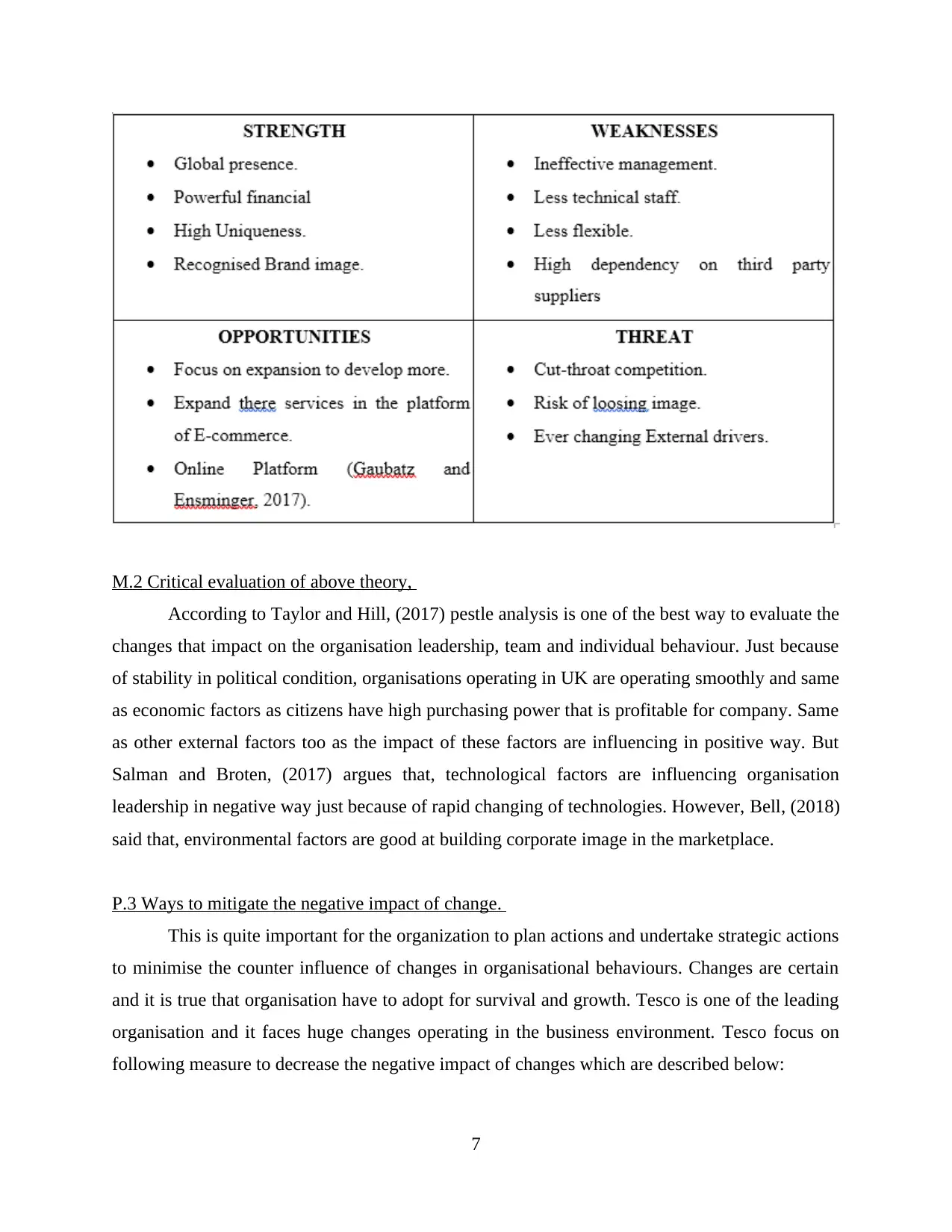
M.2 Critical evaluation of above theory,
According to Taylor and Hill, (2017) pestle analysis is one of the best way to evaluate the
changes that impact on the organisation leadership, team and individual behaviour. Just because
of stability in political condition, organisations operating in UK are operating smoothly and same
as economic factors as citizens have high purchasing power that is profitable for company. Same
as other external factors too as the impact of these factors are influencing in positive way. But
Salman and Broten, (2017) argues that, technological factors are influencing organisation
leadership in negative way just because of rapid changing of technologies. However, Bell, (2018)
said that, environmental factors are good at building corporate image in the marketplace.
P.3 Ways to mitigate the negative impact of change.
This is quite important for the organization to plan actions and undertake strategic actions
to minimise the counter influence of changes in organisational behaviours. Changes are certain
and it is true that organisation have to adopt for survival and growth. Tesco is one of the leading
organisation and it faces huge changes operating in the business environment. Tesco focus on
following measure to decrease the negative impact of changes which are described below:
7
According to Taylor and Hill, (2017) pestle analysis is one of the best way to evaluate the
changes that impact on the organisation leadership, team and individual behaviour. Just because
of stability in political condition, organisations operating in UK are operating smoothly and same
as economic factors as citizens have high purchasing power that is profitable for company. Same
as other external factors too as the impact of these factors are influencing in positive way. But
Salman and Broten, (2017) argues that, technological factors are influencing organisation
leadership in negative way just because of rapid changing of technologies. However, Bell, (2018)
said that, environmental factors are good at building corporate image in the marketplace.
P.3 Ways to mitigate the negative impact of change.
This is quite important for the organization to plan actions and undertake strategic actions
to minimise the counter influence of changes in organisational behaviours. Changes are certain
and it is true that organisation have to adopt for survival and growth. Tesco is one of the leading
organisation and it faces huge changes operating in the business environment. Tesco focus on
following measure to decrease the negative impact of changes which are described below:
7
⊘ This is a preview!⊘
Do you want full access?
Subscribe today to unlock all pages.

Trusted by 1+ million students worldwide
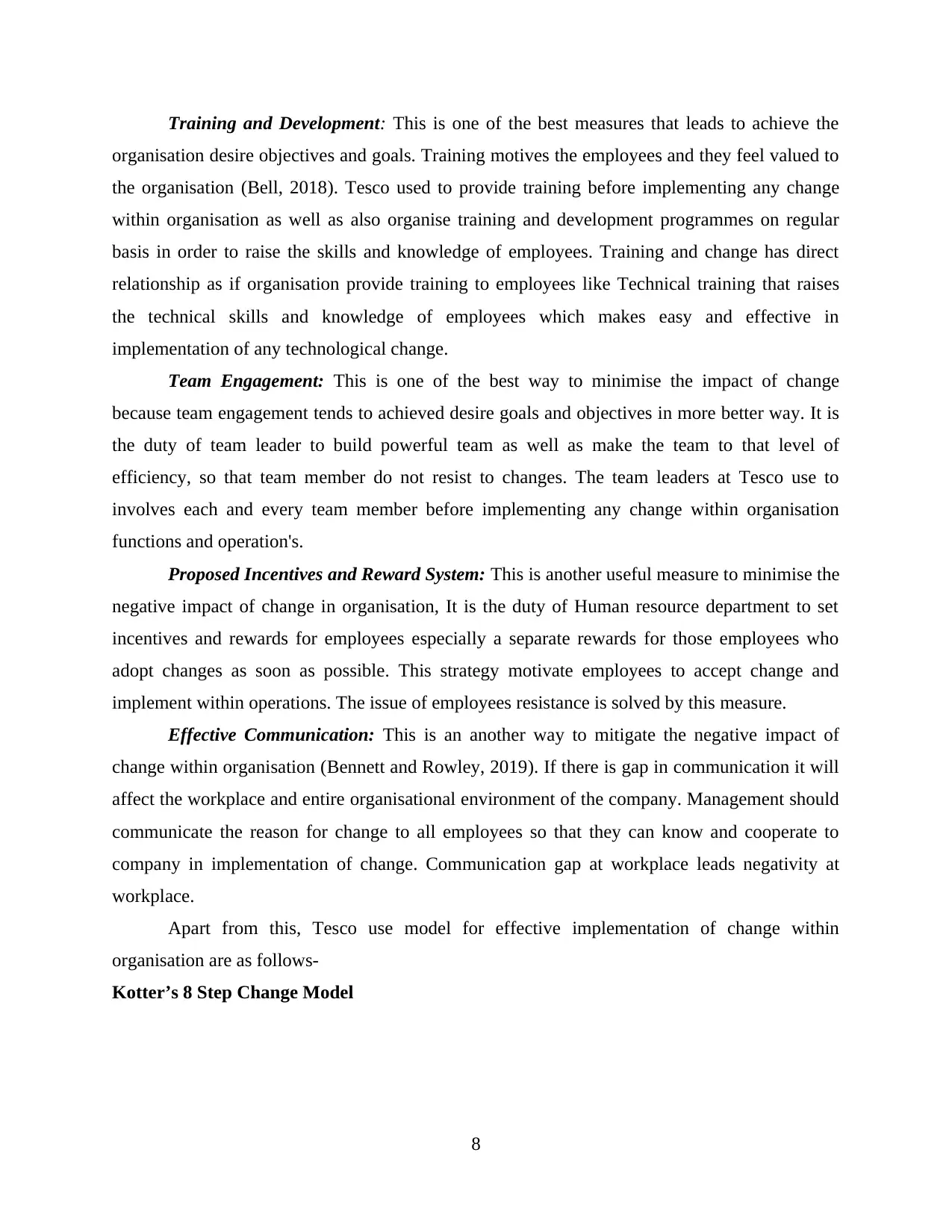
Training and Development: This is one of the best measures that leads to achieve the
organisation desire objectives and goals. Training motives the employees and they feel valued to
the organisation (Bell, 2018). Tesco used to provide training before implementing any change
within organisation as well as also organise training and development programmes on regular
basis in order to raise the skills and knowledge of employees. Training and change has direct
relationship as if organisation provide training to employees like Technical training that raises
the technical skills and knowledge of employees which makes easy and effective in
implementation of any technological change.
Team Engagement: This is one of the best way to minimise the impact of change
because team engagement tends to achieved desire goals and objectives in more better way. It is
the duty of team leader to build powerful team as well as make the team to that level of
efficiency, so that team member do not resist to changes. The team leaders at Tesco use to
involves each and every team member before implementing any change within organisation
functions and operation's.
Proposed Incentives and Reward System: This is another useful measure to minimise the
negative impact of change in organisation, It is the duty of Human resource department to set
incentives and rewards for employees especially a separate rewards for those employees who
adopt changes as soon as possible. This strategy motivate employees to accept change and
implement within operations. The issue of employees resistance is solved by this measure.
Effective Communication: This is an another way to mitigate the negative impact of
change within organisation (Bennett and Rowley, 2019). If there is gap in communication it will
affect the workplace and entire organisational environment of the company. Management should
communicate the reason for change to all employees so that they can know and cooperate to
company in implementation of change. Communication gap at workplace leads negativity at
workplace.
Apart from this, Tesco use model for effective implementation of change within
organisation are as follows-
Kotter’s 8 Step Change Model
8
organisation desire objectives and goals. Training motives the employees and they feel valued to
the organisation (Bell, 2018). Tesco used to provide training before implementing any change
within organisation as well as also organise training and development programmes on regular
basis in order to raise the skills and knowledge of employees. Training and change has direct
relationship as if organisation provide training to employees like Technical training that raises
the technical skills and knowledge of employees which makes easy and effective in
implementation of any technological change.
Team Engagement: This is one of the best way to minimise the impact of change
because team engagement tends to achieved desire goals and objectives in more better way. It is
the duty of team leader to build powerful team as well as make the team to that level of
efficiency, so that team member do not resist to changes. The team leaders at Tesco use to
involves each and every team member before implementing any change within organisation
functions and operation's.
Proposed Incentives and Reward System: This is another useful measure to minimise the
negative impact of change in organisation, It is the duty of Human resource department to set
incentives and rewards for employees especially a separate rewards for those employees who
adopt changes as soon as possible. This strategy motivate employees to accept change and
implement within operations. The issue of employees resistance is solved by this measure.
Effective Communication: This is an another way to mitigate the negative impact of
change within organisation (Bennett and Rowley, 2019). If there is gap in communication it will
affect the workplace and entire organisational environment of the company. Management should
communicate the reason for change to all employees so that they can know and cooperate to
company in implementation of change. Communication gap at workplace leads negativity at
workplace.
Apart from this, Tesco use model for effective implementation of change within
organisation are as follows-
Kotter’s 8 Step Change Model
8
Paraphrase This Document
Need a fresh take? Get an instant paraphrase of this document with our AI Paraphraser
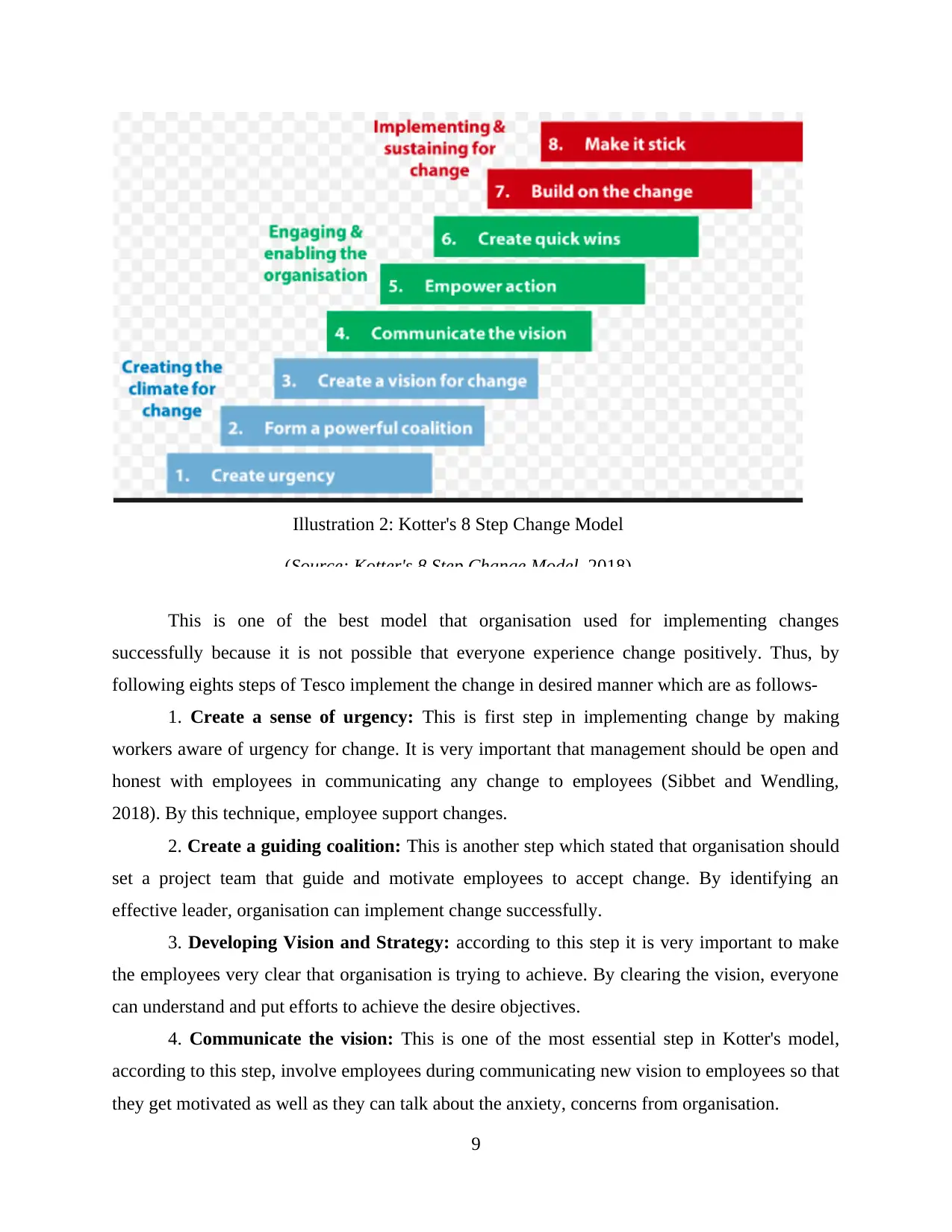
This is one of the best model that organisation used for implementing changes
successfully because it is not possible that everyone experience change positively. Thus, by
following eights steps of Tesco implement the change in desired manner which are as follows-
1. Create a sense of urgency: This is first step in implementing change by making
workers aware of urgency for change. It is very important that management should be open and
honest with employees in communicating any change to employees (Sibbet and Wendling,
2018). By this technique, employee support changes.
2. Create a guiding coalition: This is another step which stated that organisation should
set a project team that guide and motivate employees to accept change. By identifying an
effective leader, organisation can implement change successfully.
3. Developing Vision and Strategy: according to this step it is very important to make
the employees very clear that organisation is trying to achieve. By clearing the vision, everyone
can understand and put efforts to achieve the desire objectives.
4. Communicate the vision: This is one of the most essential step in Kotter's model,
according to this step, involve employees during communicating new vision to employees so that
they get motivated as well as they can talk about the anxiety, concerns from organisation.
9
Illustration 2: Kotter's 8 Step Change Model
(Source: Kotter's 8 Step Change Model, 2018)
successfully because it is not possible that everyone experience change positively. Thus, by
following eights steps of Tesco implement the change in desired manner which are as follows-
1. Create a sense of urgency: This is first step in implementing change by making
workers aware of urgency for change. It is very important that management should be open and
honest with employees in communicating any change to employees (Sibbet and Wendling,
2018). By this technique, employee support changes.
2. Create a guiding coalition: This is another step which stated that organisation should
set a project team that guide and motivate employees to accept change. By identifying an
effective leader, organisation can implement change successfully.
3. Developing Vision and Strategy: according to this step it is very important to make
the employees very clear that organisation is trying to achieve. By clearing the vision, everyone
can understand and put efforts to achieve the desire objectives.
4. Communicate the vision: This is one of the most essential step in Kotter's model,
according to this step, involve employees during communicating new vision to employees so that
they get motivated as well as they can talk about the anxiety, concerns from organisation.
9
Illustration 2: Kotter's 8 Step Change Model
(Source: Kotter's 8 Step Change Model, 2018)
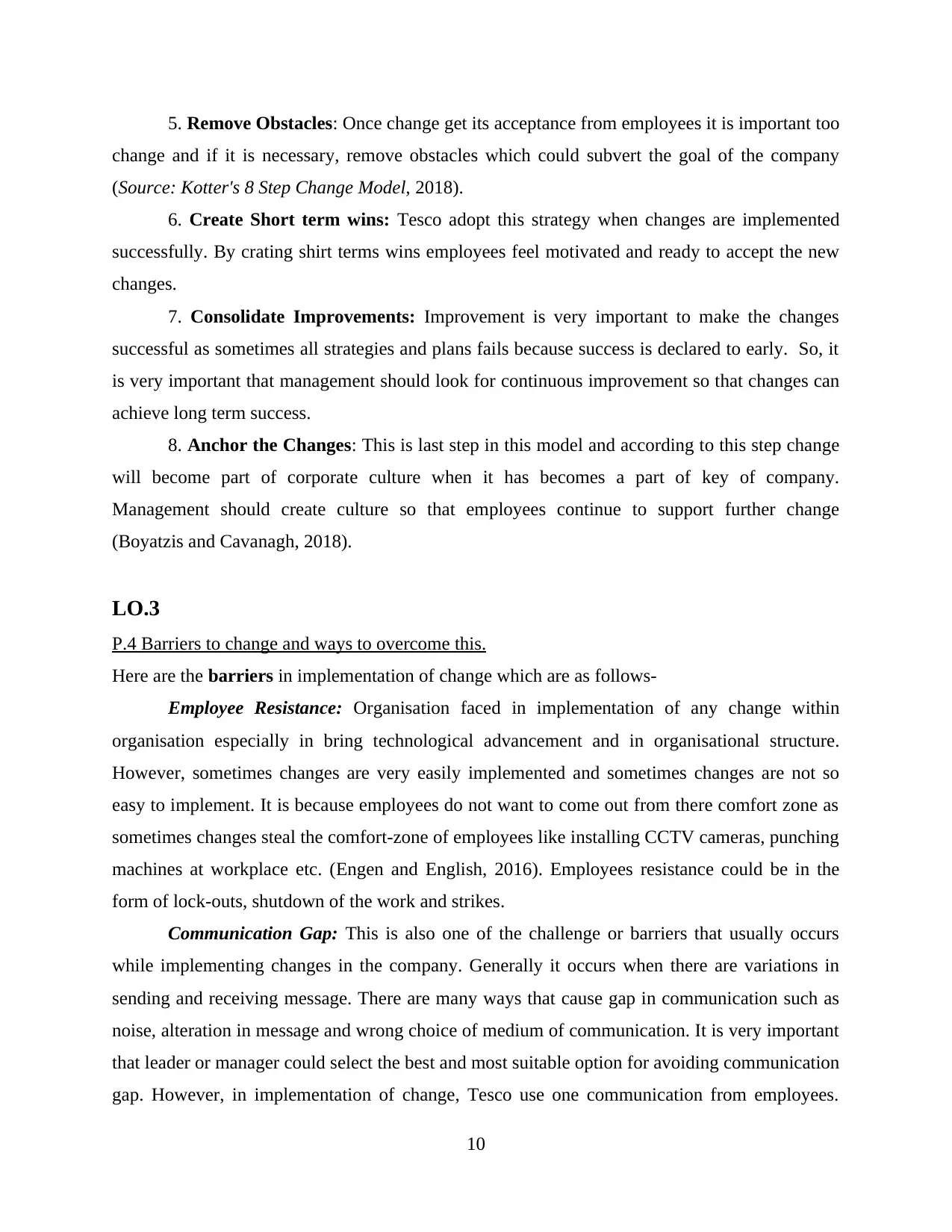
5. Remove Obstacles: Once change get its acceptance from employees it is important too
change and if it is necessary, remove obstacles which could subvert the goal of the company
(Source: Kotter's 8 Step Change Model, 2018).
6. Create Short term wins: Tesco adopt this strategy when changes are implemented
successfully. By crating shirt terms wins employees feel motivated and ready to accept the new
changes.
7. Consolidate Improvements: Improvement is very important to make the changes
successful as sometimes all strategies and plans fails because success is declared to early. So, it
is very important that management should look for continuous improvement so that changes can
achieve long term success.
8. Anchor the Changes: This is last step in this model and according to this step change
will become part of corporate culture when it has becomes a part of key of company.
Management should create culture so that employees continue to support further change
(Boyatzis and Cavanagh, 2018).
LO.3
P.4 Barriers to change and ways to overcome this.
Here are the barriers in implementation of change which are as follows-
Employee Resistance: Organisation faced in implementation of any change within
organisation especially in bring technological advancement and in organisational structure.
However, sometimes changes are very easily implemented and sometimes changes are not so
easy to implement. It is because employees do not want to come out from there comfort zone as
sometimes changes steal the comfort-zone of employees like installing CCTV cameras, punching
machines at workplace etc. (Engen and English, 2016). Employees resistance could be in the
form of lock-outs, shutdown of the work and strikes.
Communication Gap: This is also one of the challenge or barriers that usually occurs
while implementing changes in the company. Generally it occurs when there are variations in
sending and receiving message. There are many ways that cause gap in communication such as
noise, alteration in message and wrong choice of medium of communication. It is very important
that leader or manager could select the best and most suitable option for avoiding communication
gap. However, in implementation of change, Tesco use one communication from employees.
10
change and if it is necessary, remove obstacles which could subvert the goal of the company
(Source: Kotter's 8 Step Change Model, 2018).
6. Create Short term wins: Tesco adopt this strategy when changes are implemented
successfully. By crating shirt terms wins employees feel motivated and ready to accept the new
changes.
7. Consolidate Improvements: Improvement is very important to make the changes
successful as sometimes all strategies and plans fails because success is declared to early. So, it
is very important that management should look for continuous improvement so that changes can
achieve long term success.
8. Anchor the Changes: This is last step in this model and according to this step change
will become part of corporate culture when it has becomes a part of key of company.
Management should create culture so that employees continue to support further change
(Boyatzis and Cavanagh, 2018).
LO.3
P.4 Barriers to change and ways to overcome this.
Here are the barriers in implementation of change which are as follows-
Employee Resistance: Organisation faced in implementation of any change within
organisation especially in bring technological advancement and in organisational structure.
However, sometimes changes are very easily implemented and sometimes changes are not so
easy to implement. It is because employees do not want to come out from there comfort zone as
sometimes changes steal the comfort-zone of employees like installing CCTV cameras, punching
machines at workplace etc. (Engen and English, 2016). Employees resistance could be in the
form of lock-outs, shutdown of the work and strikes.
Communication Gap: This is also one of the challenge or barriers that usually occurs
while implementing changes in the company. Generally it occurs when there are variations in
sending and receiving message. There are many ways that cause gap in communication such as
noise, alteration in message and wrong choice of medium of communication. It is very important
that leader or manager could select the best and most suitable option for avoiding communication
gap. However, in implementation of change, Tesco use one communication from employees.
10
⊘ This is a preview!⊘
Do you want full access?
Subscribe today to unlock all pages.

Trusted by 1+ million students worldwide
1 out of 21
Related Documents
Your All-in-One AI-Powered Toolkit for Academic Success.
+13062052269
info@desklib.com
Available 24*7 on WhatsApp / Email
![[object Object]](/_next/static/media/star-bottom.7253800d.svg)
Unlock your academic potential
Copyright © 2020–2025 A2Z Services. All Rights Reserved. Developed and managed by ZUCOL.




